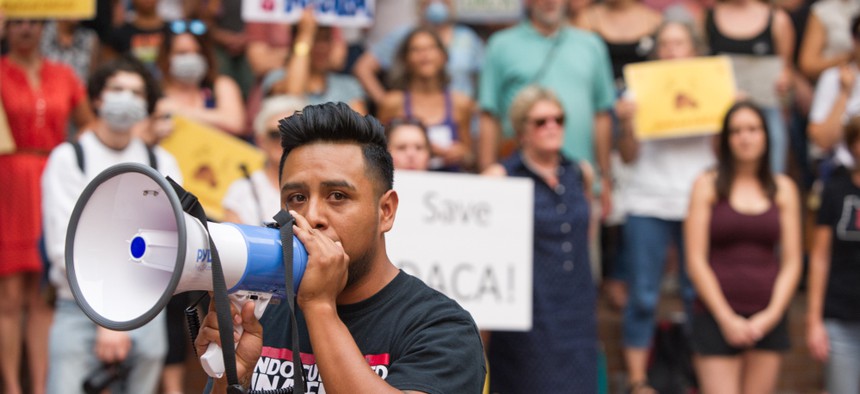New York City
Could the long-stalled state DREAM Act finally advance this year?
As the national debate rages about the DREAM Act, the New York state version is back in the spotlight as well. Gov. Andrew Cuomo has included it as an education priority in his executive budget, and the Assembly has included the bill in its budget resolution as well, although state Senate Republicans remain opposed.

DACA protest Diego G Diaz/Shutterstock
As the national debate rages about the DREAM Act, the New York state version is back in the spotlight as well. Gov. Andrew Cuomo has included it as an education priority in his executive budget, and the Assembly has included the bill in its budget resolution as well. Supporters hope this will finally be the year that the bill passes as part of the budget.
The New York DREAM Act was first introduced in the state Legislature in 2013, with state Sen. José Peralta and then-Assemblyman Francisco Moya as the sponsors in each chamber. States don’t have the ability to grant citizenship to undocumented immigrants, as the national version would for those who entered the country illegally as children. The state bill instead would allow college-bound undocumented immigrants to access the same in-state scholarships and financial aid available to U.S. citizens. The bill has passed the Assembly every time it has been brought to the floor, but has been met with harsh opposition by the Republican-controlled state Senate.
Peralta told City & State he is hopeful that the bill will get included this year with the support of Cuomo and thanks to the spotlight on the national DREAM Act after President Donald Trump announced he would end the Deferred Action for Childhood Arrivals program, which provides protection for undocumented immigrants who entered the country illegally as children.
“I’m assuming, if it stays in the budget, it will be in ELFA (Education, Labor and Family Assistance). So (Republicans) can vote against the ELFA piece of the budget. That would probably not be a smart move for them during an election year being that most of the other pieces for education would be included in that,” said Peralta, who is a member of the Independent Democratic Conference, which has a power-sharing arrangement with the state Senate Republicans.
However, that is still a big “if” that Peralta is referring to. The DREAM Act has been included in Cuomo’s executive budget proposal every year since 2015, but has been always been removed during negotiations, allowing Republicans to avoid voting against parts of the budget.
Assemblyman Marcos Crespo doubted enough has changed since last year to make a difference. “The members are who they are. The Republican conference has said what they’ve said. They continue to make it their line in the sand,” Crespo told City & State. Crespo added that he worries Republicans will “once again remain an obstacle” to keeping the DREAM Act in the final budget, which is due by April 1.
Indeed, state Senate Majority Leader John Flanagan has made his party’s stance very clear. “Our members are very strongly opposed to the DREAM Act,” he said last year, according to the Times Union.
Peralta argued that Cuomo has additional incentive this year to “stick to it” and really push for the DREAM Act to be included in the budget with a potential 2020 presidential run in the governor’s future.
“I think this just makes complete sense for him to move forward and actually make an example of what New York can do for the rest of the country,” Peralta said. “And I think we’re in a very good position.”
Cuomo has at times been able to pass progressive legislation despite a Republican-controlled state Senate, as he did in legalizing same-sex marriage in 2011 and signing the SAFE Act gun control measures in 2013. He has also been trying to highlight his progressive politics as he faces a potential gubernatorial challenge from Cynthia Nixon from the left.
If Cuomo does not keep the DREAM Act in the budget this year, Peralta said the goal is to unify every Democrat in the state Senate to vote for the bill. Before state Sens. Rubén Díaz Sr. and George Latimer left midsession, the Democrats technically held a 32-seat majority. Peralta expects that the two special elections set for April 24 will usher in Democrats, keeping that number at 32, enough votes to pass.
Despite internecine strife on other issues, every IDC member is a co-sponsor of the DREAM Act, and a spokesman for state Senate Minority Leader Andrea Stewart-Cousins said that every mainline Democrat, including the two candidates in the special elections, supports the legislation as well.
The first and only time the DREAM Act came to a vote in the state Senate, the circumstances were similar. Republicans controlled the chamber, but Democrats had a 32-seat majority. The bill failed by two votes. One “no” vote was from state Sen. Ted O’Brien, an upstate Democrat who was voted out of office in 2014. The other was state Sen. Simcha Felder, a Brooklyn Democrat who is still in office and caucuses with the Republicans.
Felder is the wild card in the DREAM Act debate. Without him, the bill likely would fall one vote short of passing despite a unified front by the IDC and mainline Democrats. Peralta said he is in constant conversation with Felder about the DREAM Act in case it doesn’t make it into the budget. But he still remained very hopeful that won’t happen.
“That’s probably going to be the best bet that it actually sort of forces people’s hands to make a decision during this election year,” Peralta said. “And it’s going to be very important, very powerful.”

